Prediction of Indoor Air Exposure from Outdoor Air Quality Using an Artificial Neural Network Model for Inner City Commercial Buildings
Abstract
:1. Introduction
2. Experimental Section
2.1. Experimental Data
| Site No. | Building Type | Vent. Type | Age (Years) | Opening (h) | Run 1 | Run 2 | ||
|---|---|---|---|---|---|---|---|---|
| Nt2 | Office | Nat. | ~120 | 10 a.m.–6 p.m. | 26–29 April 2011 | Ground | 27 June–1 July 2011 | Ground |
| Mc2 | Office | Mech. | ~5 | 8 a.m.–6 p.m. | 6–9 July 2010 | Roof | 12–15 July 2010 | Ground |
| Mc3 | Shop | Mech. | ~5 | 8 a.m.–8 p.m. | 13–16 December 2010 | Ground | 27–31 March 2011 | Roof/Ground |
2.2. Artificial Neural Network Model
- J—Local gradient of f with respect to β
- β—Parameters
- y—Independent and dependent variables
- —Increment
Input Parameters
2.3. Prediction of Outdoor Levels using PALM Model
- (1)
- Modelled background concentration levels;
- (2)
- Modelled traffic related concentration levels in urban and sub-urban environments;
- (3)
- Modelled industrial sources related concentration levels;
- (4)
- Modelled domestic sources related concentration levels;
Data for PALM Model
- (1)
- Weather data: weather data at an hourly time step was obtained from Met Eireann for the Dublin Airport synoptic stations (located 8 km from the city centre on the north side of the city) for: wind speed, wind direction, temperature, humidity, dew point, atmospheric pressure, rainfall, solar radiation and atmospheric stability classes.
- (2)
- NO2 and PM2.5 data: daily average NO2 and PM2.5 concentration levels were sourced from the monitoring stations in the Great Dublin Area, classified as “Background” stations by the Irish EPA.
- (3)
- Traffic data: the traffic data used for the OSPM (Operational Street Pollution Model) model [37] was obtained from Dublin City Council (DCC). DCC monitors traffic continuously at different traffic intersections (critical junctions) around the city. The time resolution is was generally 15 min aggregate data. For the motorways, Port Tunnel, etc., information is collected by The National Road Authority (NRA) and then stored/archived by DCC.
- (4)
- Building geometry and road network: streets and buildings data for the Great Dublin Area were supplied by Dublin City Council in GIS format; as such the initial main challenge in using OSPM in this project is to import these street and buildings data into the environmental software. The buildings and road network were imported in OSPM using AirGIS [39].
2.4. Forward Prediction of Indoor Air Quality using Artificial Neural Networks
3. Results
3.1. Development of ANNs for Individual Sites
3.1.1. NO2 Artificial Neural Network Model Performance
Mc2 (Office)
Mc3 (Mechanically Ventilated Gallery Space)
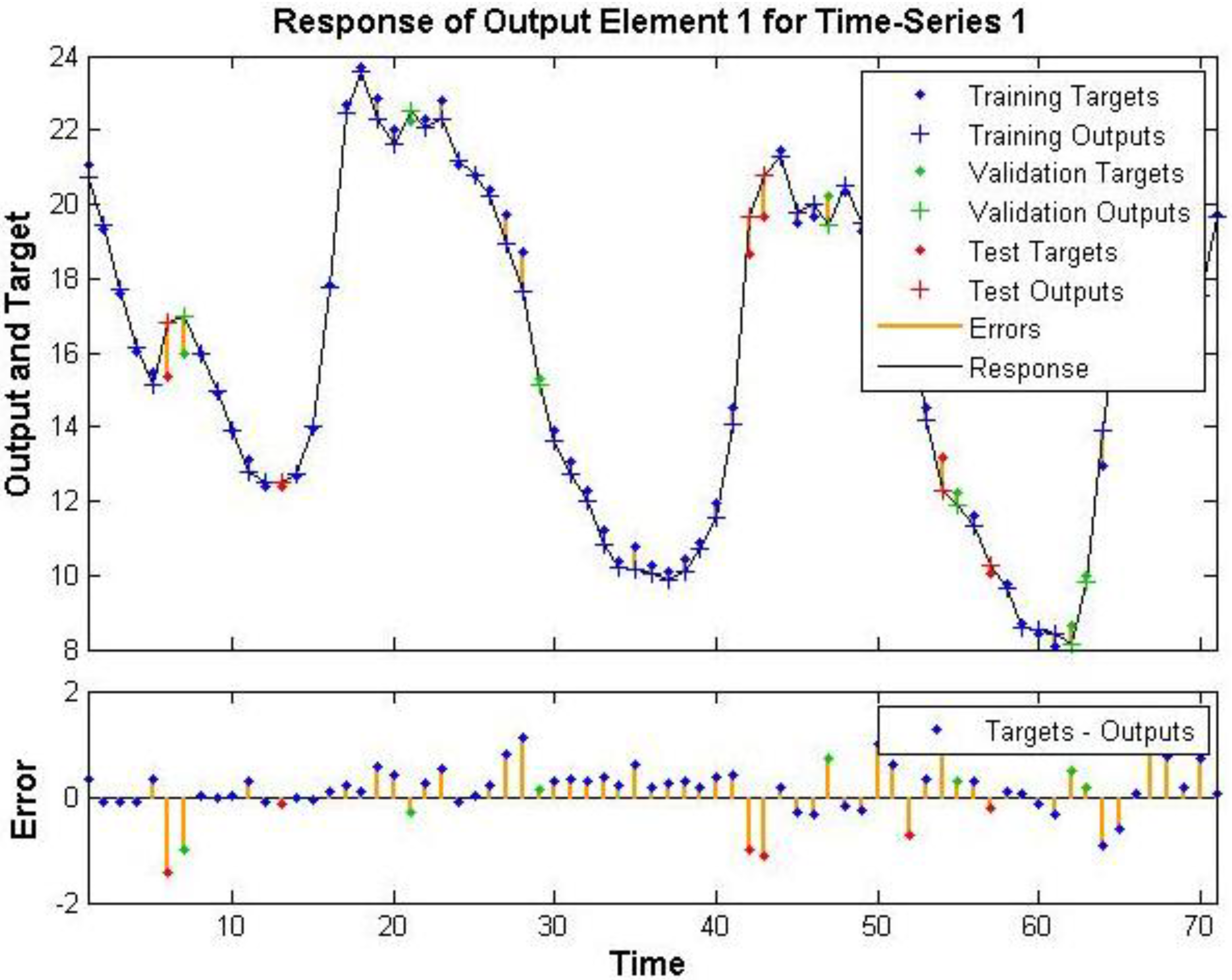

Nt2 (Naturally Ventilated Office)
3.1.2. PM2.5 Artificial Neural Network Model Performance
Mc2 (Mechanically Ventilated Office)
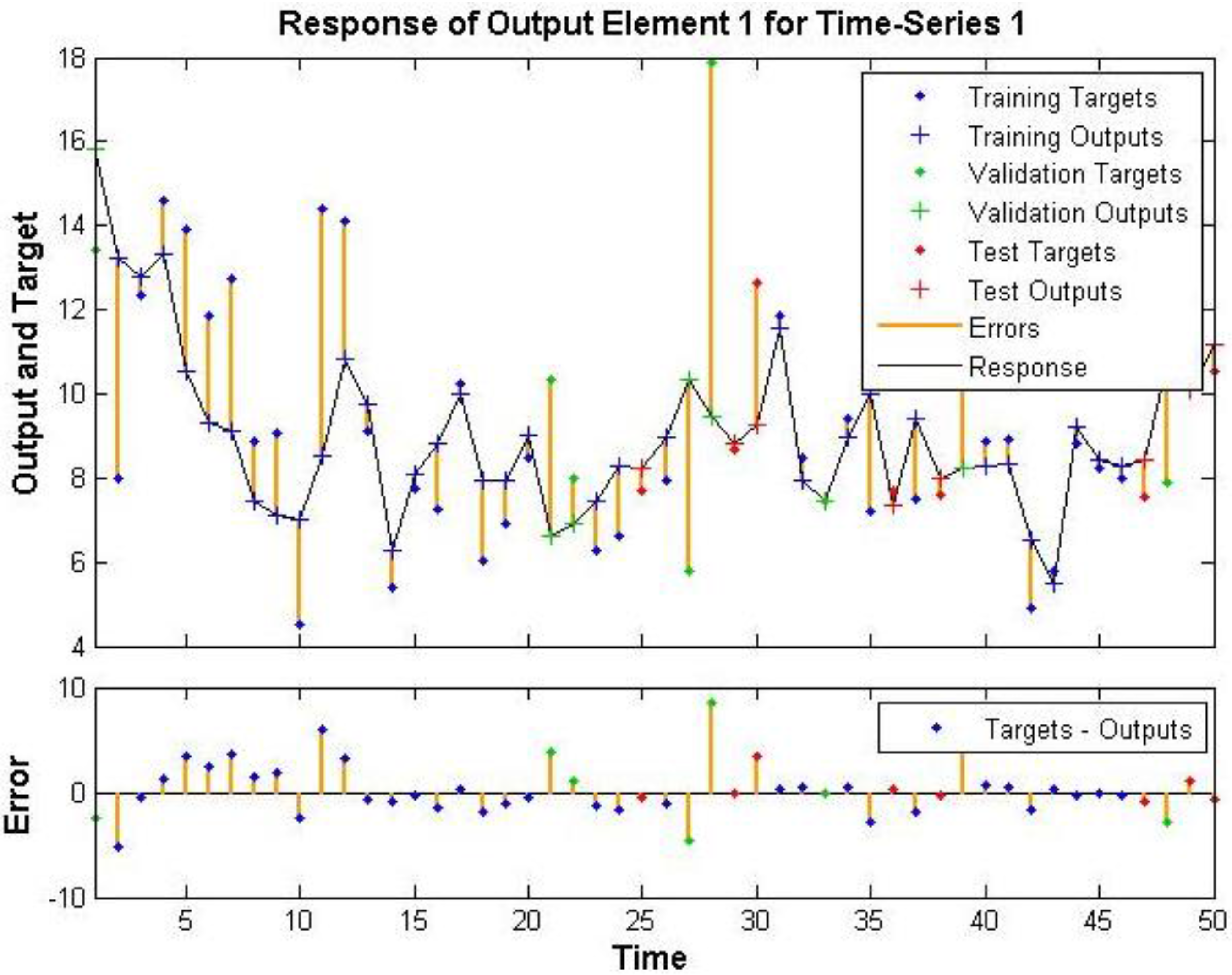

Mc3 (Mechanically Ventilated Gallery Space)

Nt2 (Naturally Ventilated Office)
3.1.3. Discussion of Trained ANNs
| Site | Training | Validation | Test | All |
|---|---|---|---|---|
| NO2 | ||||
| Mc2 Run 1 | 0.999 | 0.988 | 0.967 | 0.991 |
| Mc2 Run 2 | 1.000 | 0.815 | 0.952 | 0.968 |
| Mc3 Run 1 | 0.996 | 0.994 | 0.988 | 0.994 |
| Mc3 Run 2 | 1.000 | 0.903 | 0.965 | 0.986 |
| Nt2 Run 1 | 0.977 | 0.804 | 0.956 | 0.968 |
| Nt2 Run 2 | 1.000 | 0.915 | 0.814 | 0.980 |
| PM2.5 | ||||
| Mc2 Run 1 | 0.648 | 0.235 | 0.709 | 0.526 |
| Mc2 Run 2 | 0.985 | 0.781 | 0.776 | 0.900 |
| Mc3 Run 1 | 0.954 | 0.012 | 0.865 | 0.668 |
| Mc3 Run 2 (street) | 0.984 | 0.969 | 0.925 | 0.951 |
| PM2.5 | ||||
| Mc3 Run 2 (roof) | 0.999 | 0.965 | 0.811 | 0.966 |
| Nt2 Run 1 | 0.984 | 0.631 | 0.666 | 0.844 |
| Nt2 Run 2 | 1.000 | 0.814 | 0.940 | 0.908 |
3.2. Results from PALM Model
| Model Summary | ||
|---|---|---|
| Building | R2 | Std. Error |
| Mc2 | 0.854 | 3.15 |
| Mc3 | 0.870 | 4.66 |
| Nt2 | 0.829 | 3.91 |
3.2.1. NO2
| ANOVA | ||||||
|---|---|---|---|---|---|---|
| Building | Model | Sum of Squares | Degrees of Freedom (DF) | Mean Square | F-Test | Significance Level |
| Mc2 | Regression | 4357.6 | 1 | 4357.6 | 438.2 | 0 |
| Residual | 745.9 | 75 | 9.95 | |||
| Total | 5203.4 | 76 | ||||
| Mc3 | Regression | 10,009.2 | 1 | 10,009.2 | 460.9 | 0 |
| Residual | 1498.5 | 69 | 21.72 | |||
| Total | 11,507.6 | 70 | ||||
| Nt2 | Regression | 6980.9 | 1 | 6980.9 | 455.9 | 0 |
| Residual | 1439.3 | 94 | 15.31 | |||
| Total | 8420.3 | 95 | ||||
3.2.2. PM2.5
| Model Summary | ||
|---|---|---|
| Building | R2 | Std. Error |
| Mc2 | 0.711 | 2.17 |
| Mc3 | 0.760 | 2.06 |
| Nt2 | 0.770 | 1.85 |
| ANOVA | ||||||
|---|---|---|---|---|---|---|
| Building | Model | Sum of Squares | DF | Mean Square | F | Sig. |
| Mc2 | Regression | 810.0 | 1 | 810.0 | 172.48 | 0 |
| Residual | 328.7 | 70 | 4.696 | |||
| Total | 1138.7 | 71 | ||||
| Mc3 | Regression | 927.1 | 1 | 927.1 | 218.44 | 0 |
| Residual | 292.9 | 69 | 4.244 | |||
| Total | 1220.0 | 70 | ||||
| Nt2 | Regression | 1071.6 | 1 | 1071.6 | 311.96 | 0 |
| Residual | 319.5 | 93 | 3.435 | |||
| Total | 1391.0 | 94 | ||||
4. Forward Prediction of Indoor Data
4.1. Forward Prediction Using the Trained ANNs
4.1.1. Results of Forward Prediction of NO2 Concentrations
Mc2 (Mechanically Ventilated Office)
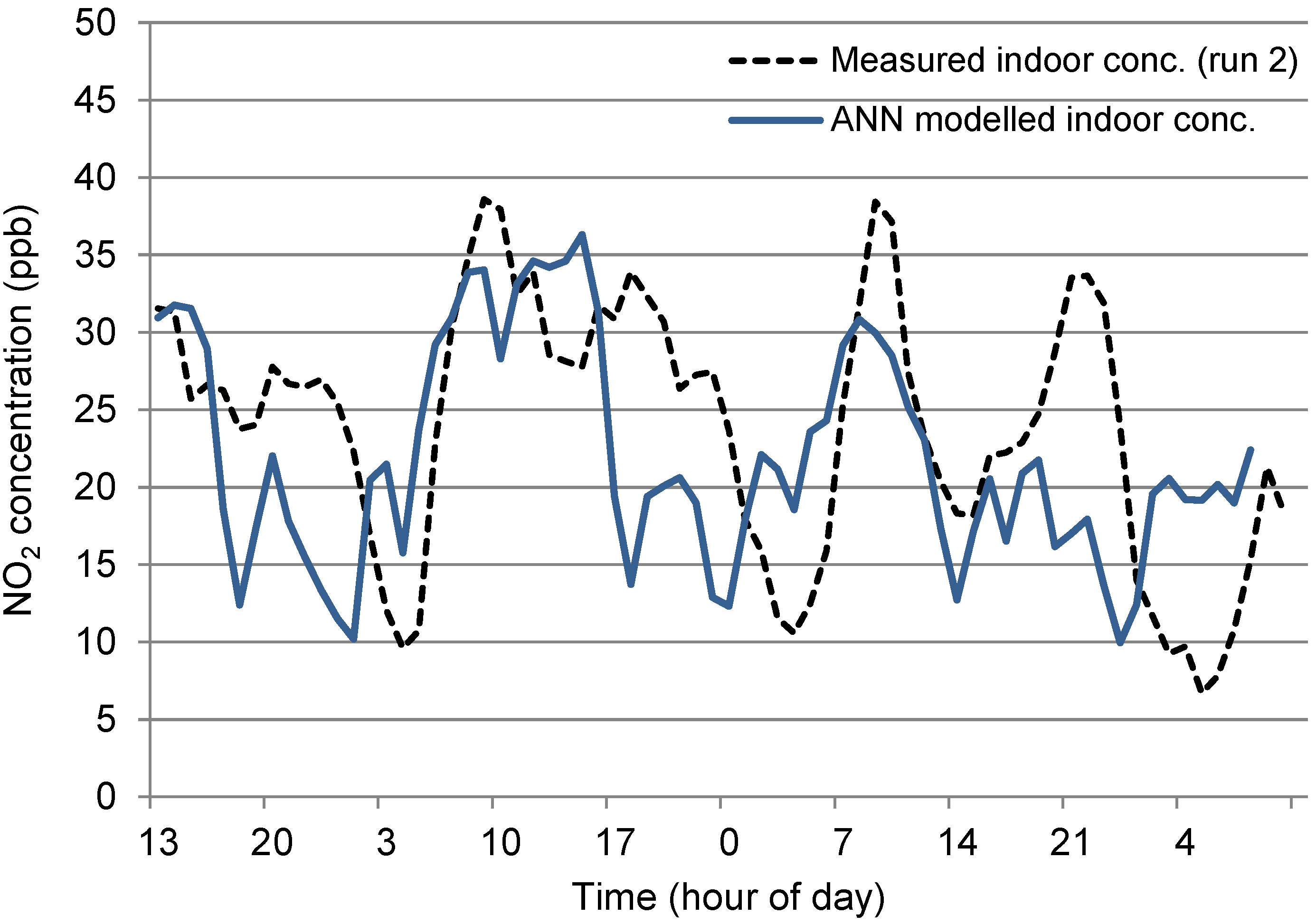
Nt2 (Naturally Ventilated Office)
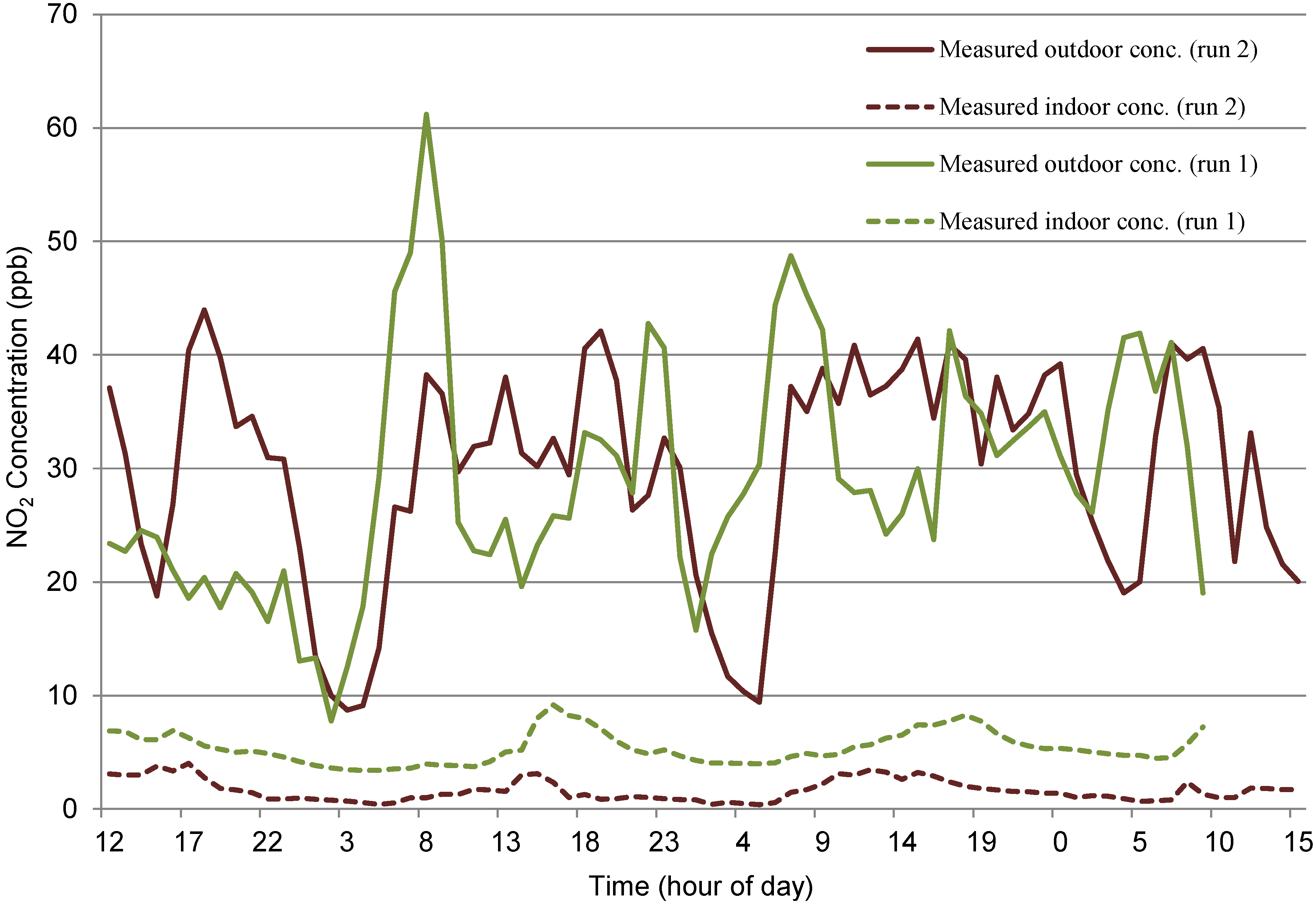

4.1.2. Results of Forward Prediction of PM2.5 Concentrations
Mc3 (Mechanically Ventilated Gallery Space)
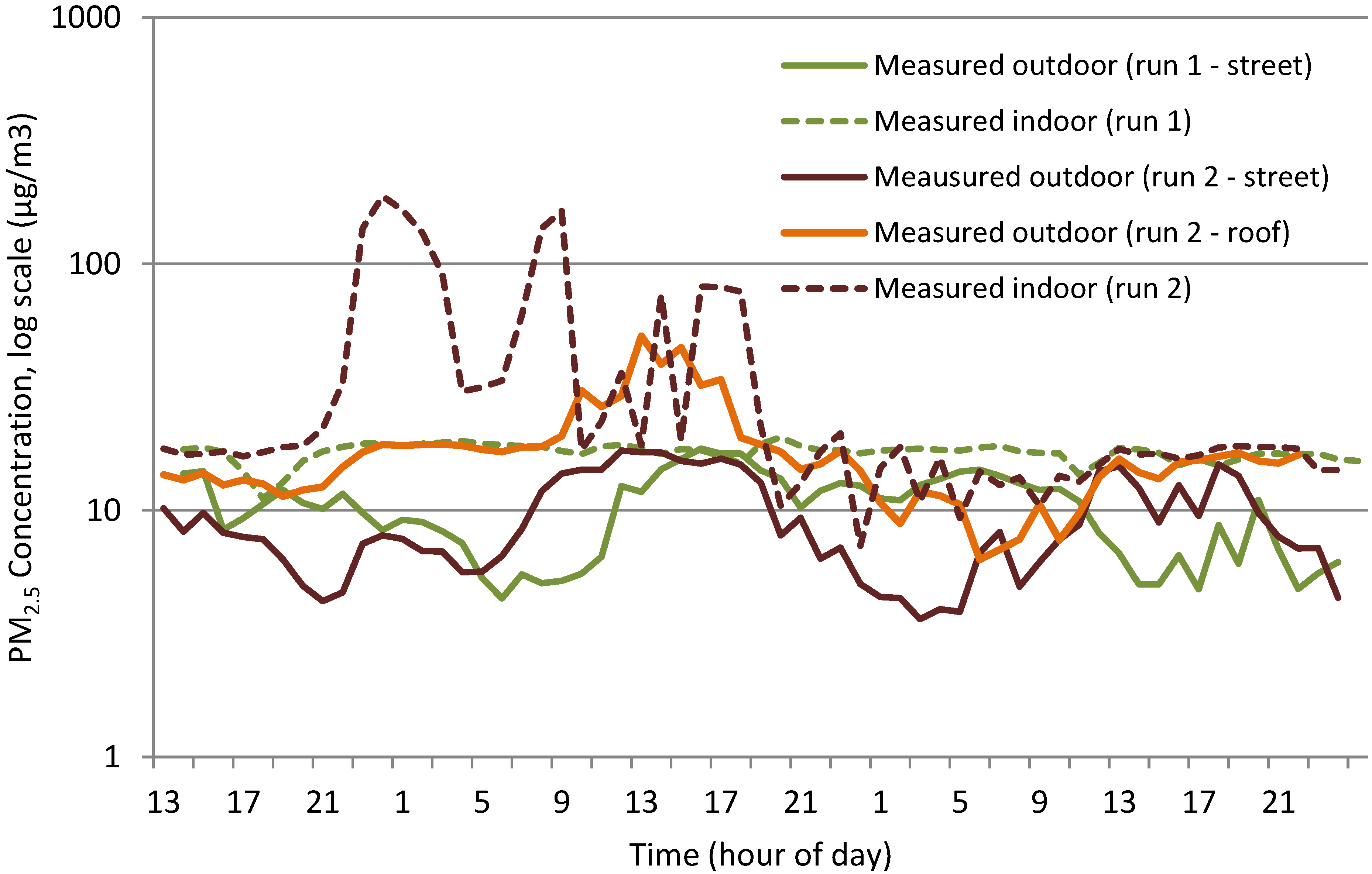

Nt2 (Naturally Ventilated Office)
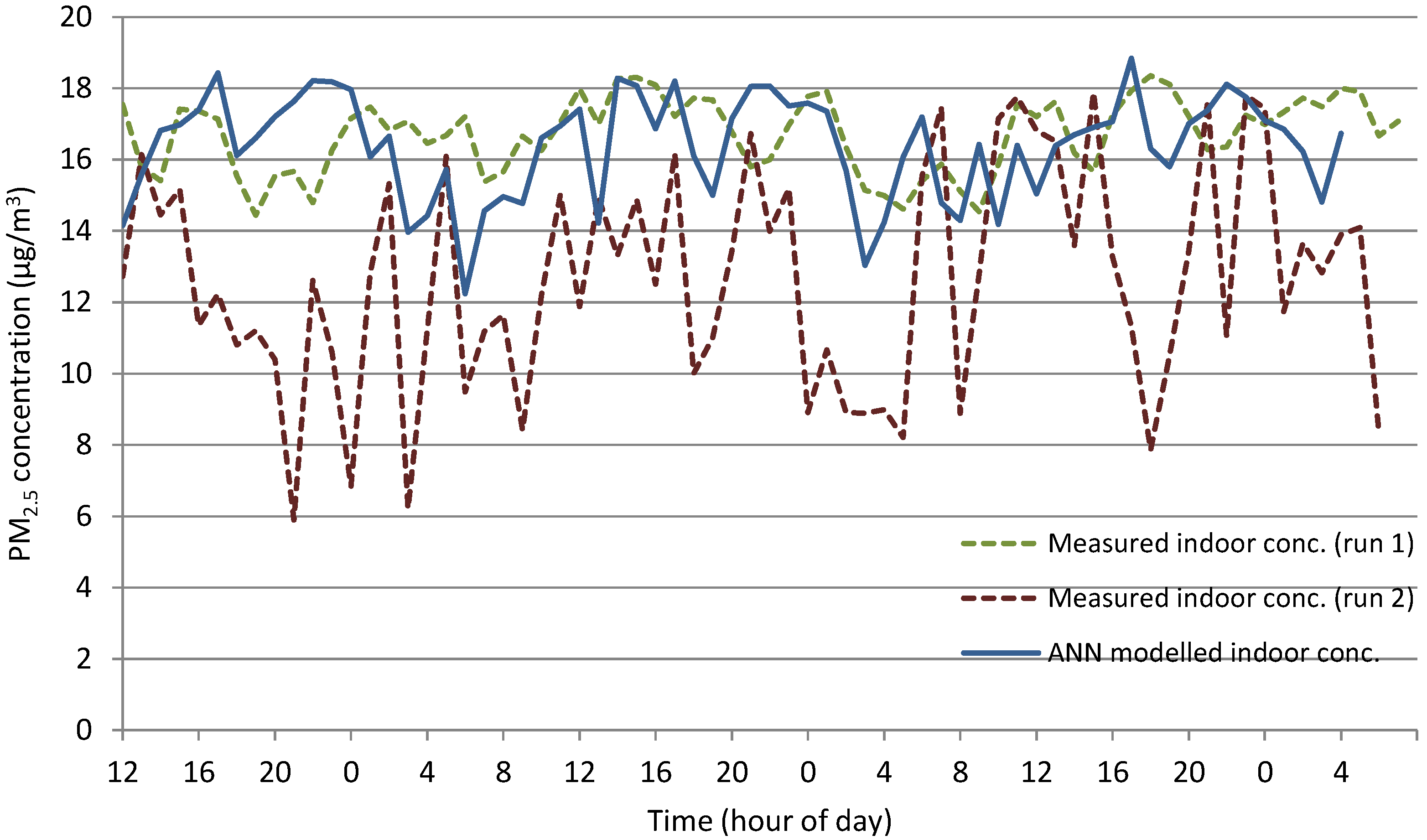
4.2. Forward Prediction of a Generic Inner City Commercial Building
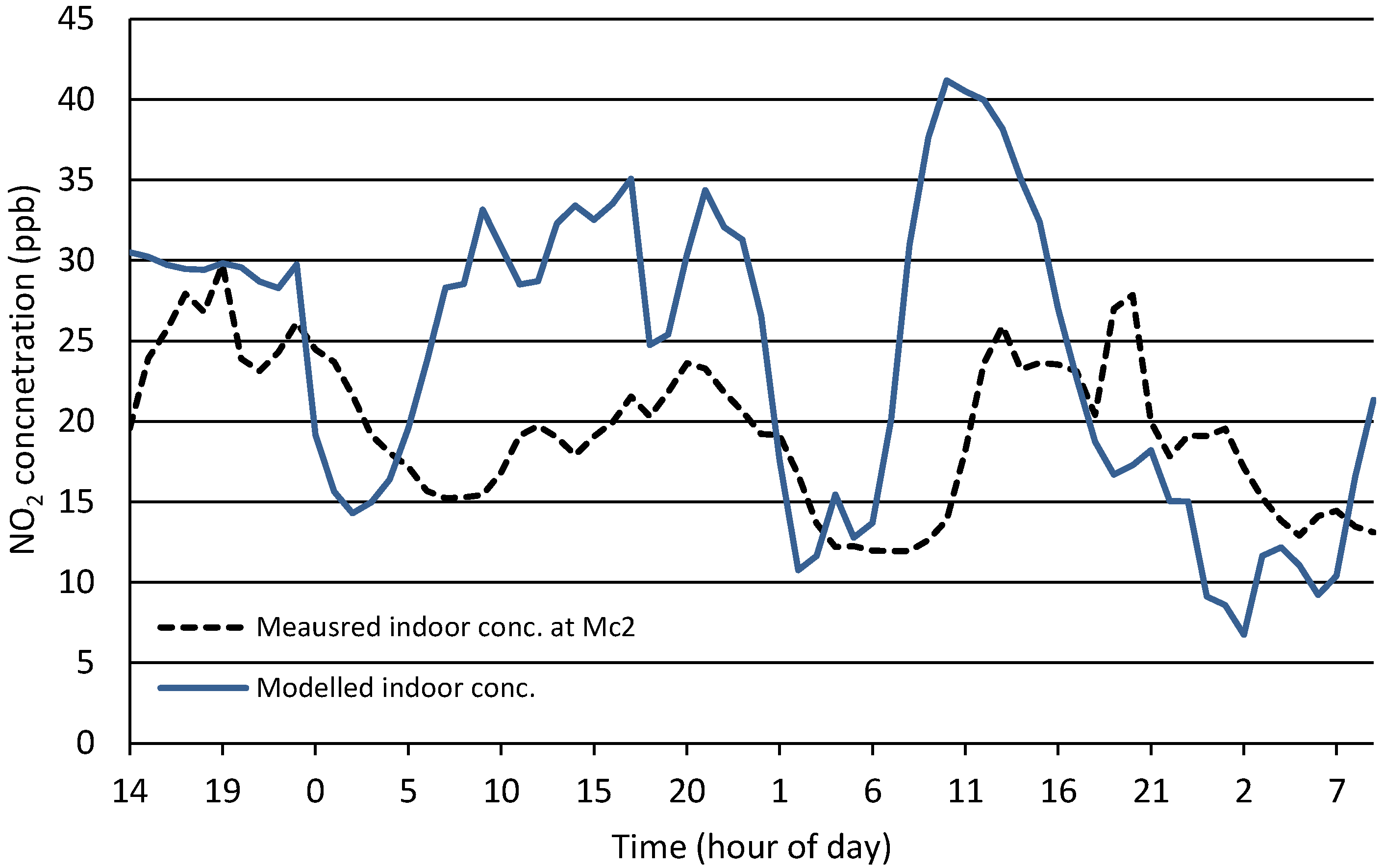
5. Discussion
5.1. Forward Prediction Ability
5.2. Implications to Public Health
6. Conclusions
Supplementary Files
Supplementary File 1Acknowledgments
Author Contributions
Conflicts of Interest
References
- UNEP. United Nations Environment Programme—Urban Air Pollution 2015. Available online: http://www.unep.org/urban_environment/Issues/urban_air.asp (accessed on 10 September 2015).
- Solomon, G.M.; Balmes, J.R. Health effects of diesel exhaust. Clin. Occup. Environ. Med. 2003, 3, 61–80. [Google Scholar] [CrossRef]
- Challoner, A.; Gill, L.W. Indoor/Outdoor air pollution relationships in ten commercial buildings: PM2.5 and NO2. Build. Environ. 2014, 80, 59–173. [Google Scholar] [CrossRef]
- APHEIS. Health Impact Assessment of Air Pollution—Local City Report; Dublin. ENHIS-1; APHEIS: Dublin, Republic of Ireland, 2006. [Google Scholar]
- CSO. Census of Population; Office, C.S., Ed.; Central Statistics Office: Dublin, Republic of Ireland, 2011. [Google Scholar]
- Ireland’s Environment 2012—An Assessment. Available online: https://www.epa.ie/pubs/reports/indicators/00061_EPA_SoE_2012.pdf (accessed on ijerph-102279).
- Ballester, F.; Medina, S.; Boldo, E.; Goodman, P.; Neuberger, M.; Iniguez, C.; Kunzli, N. Reducing ambient levels of fine particulates could substantially improve health: A mortality impact assessment for 26 European cities. J. Epidemiol. Commun. Health 2008, 62, 98–105. [Google Scholar] [CrossRef] [PubMed]
- DCC. Dublin Regional Air Quality Management Plan for Improvement in levels of Nitrogen Dioxide in Ambient Air Quality Dublin; DCC: Dublin City Council, Republic of Ireland, 2010. [Google Scholar]
- Pantazopoulou, A.; Katsouyanni, K.; Koureakremastinou, J.; Trichopoulos, D. Short-Term Effects of Air Pollution on Hospital Emergency Outpatient Visits and Admissions in the Greater Athens, Greece Area. Environ. Res. 1995, 69, 31–36. [Google Scholar] [CrossRef] [PubMed]
- European Commission. Position Paper on Air Quality: Nitrogen Dioxide. Available online: http://ec.europa.eu/environment/air/pdf/pp_no2.pdf (accessed on 23 September 2015).
- Dimitroulopoulou, C.; Ashmore, M.R.; Byrne, M.A.; Kinnersley, R.P. Modelling of indoor exposure to nitrogen dioxide in the UK. Atmos. Environ. 2001, 35, 269–279. [Google Scholar] [CrossRef]
- Hancock, T. Indicators of Environmental Health in the Urban Setting; Consultant, H.P., Ed.; Canadian Public Health Association: Ottawa, ON, Canada, 2002. [Google Scholar]
- Heerwagen, J. Green buildings, organizational success and occupant productivity. Build. Res. Inf. 2000, 28, 353–367. [Google Scholar] [CrossRef]
- Dockery, D.W.; Pope, C.A.; Xu, X.; Spengler, J.D.; Ware, J.H.; Fay, M.E.; Ferris, B.G.; Speizer, F.E. An association between air pollution and mortality in six U.S. cities. N. Engl. J. Med. 1993, 329, 1753–1759. [Google Scholar] [CrossRef] [PubMed]
- Clancy, L.; Goodman, P.; Sinclair, H.; Dockery, D.W. Effect of air-pollution control on death rates in Dublin, Ireland: An intervention study. Lancet 2002, 360, 1210–1214. [Google Scholar] [CrossRef]
- Kousa, A.; Monn, C.; Rotko, T.; Alm, S.; Oglesby, L.; Jantunen, M.J. Personal exposures to NO2 in the EXPOLIS-study: Relation to residential indoor, outdoor and workplace concentrations in Basel, Helsinki and Prague. Atmos. Environ. 2001, 35, 3405–3412. [Google Scholar] [CrossRef]
- Kousa, A.; Oglesby, L.; Koistinen, K.; Kunzli, N.; Jantunen, M. Exposure chain of urban air PM2.5—Associations between ambient fixed site, residential outdoor, indoor, workplace and personal exposures in four European cities in the EXPOLIS-study. Atmos. Environ. 2002, 36, 3031–3039. [Google Scholar] [CrossRef]
- Mosqueron, L.; Momas, I.; le Moullec, Y. Personal exposure of Paris office workers to nitrogen dioxide and fine particles. Occup. Environ. Med. 2002, 59, 550–555. [Google Scholar] [CrossRef] [PubMed]
- Zeger, S.L.; Thomas, D.; Dominici, F.; Samet, J.M.; Schwartz, J.; Dockery, D.; Cohen, A. Exposure measurement error in time-series studies of air pollution: Concepts and consequences. Environ. Health Perspect. 2000, 108, 419–426. [Google Scholar] [CrossRef] [PubMed]
- The AIRMEX Project; Comparison of Indoor, Outdoor and Personal Exposure Concentrations of VOCs across European Cities. Available online: http://journals.lww.com/epidem/Fulltext/2006/11001/The_AIRMEX_Project__Comparison_of_Indoor,_Outdoor.1219.aspx (accessed on 23 September 2015).
- Lu, W.-Z.; Wang, D. Ground-level ozone prediction by support vector machine approach with a cost-sensitive classification scheme. Sci. Total Environ. 2008, 395, 109–116. [Google Scholar]
- Moustris, K.P.; Nastos, P.T.; Larissi, I.K.; Paliatsos, A.G. Application of multiple linear regression models and artificial neural networks on the surface ozone forecast in the greater Athens Area, Greece. Adv. Meteorol. 2012, 2012. [Google Scholar] [CrossRef]
- Dominick, D.; Juahir, H.; Latif, M.T.; Zain, S.M. Spatial assessment of air quality patterns in Malaysia using multivariate analysis. Atmos. Environ. 2012, 60, 172–181. [Google Scholar] [CrossRef]
- Lu, W.Z.; Wang, D. Learning machines: Rationale and application in ground-level ozone prediction. Appl. Soft Comput. 2014, 24, 135–141. [Google Scholar] [CrossRef]
- Wang, Z.Y.; Lu, F.; He, H.D.; Lu, Q.C.; Wang, D.S.; Peng, Z.R. Fine-scale estimation of carbon monoxide and fine particulate matter concentrations in proximity to a road intersection by using wavelet neural network with genetic algorithm. Atmos. Environ. 2015, 104, 264–272. [Google Scholar] [CrossRef]
- Broderick, B.; Byrne, M.; McNabola, A.; Gill, L.W.; Pilla, F.; McGrath, J.; McCreddin, A. PALM: A Personal Activity-Location Model of Exposure to Air Pollution; Environmental Protection Agency: Wexford, Ireland, 2015. [Google Scholar]
- Pilla, F.; Broderick, B. A GIS model for personal exposure to PM10 for Dublin commuters. Sustain. Cities Soc. 2015, 15, 1–10. [Google Scholar] [CrossRef]
- Kindangen, J.I. Artificial neural networks and naturally ventilated buildings. Build. Res. Inf. 1996, 24, 203–208. [Google Scholar] [CrossRef]
- Sun, G.; Hoff, S.J. Prediction of indoor climate and long-term air quality using a building thermal transient model, artificial neural networks and typical meteorological year. In proceeding of the American Society of Agricultural and Biological Engineers Annual International Meeting, Reno, NV, USA, 21–24 June 2009.
- Levenberg, K. A method for the solution of certain problems in least squares. Q. Appl. Math. 1944, 2, 167–168. [Google Scholar]
- Marquardt, D. An Algorithm for Least-Squares Estimation of Nonlinear Parameters. SIAM J. Appl. Math. 1963, 11, 431–441. [Google Scholar] [CrossRef]
- Bjorck, A. Numerical Methods for Least Squares Problems; Linköping University: Linköping, Sweden, 1996. [Google Scholar]
- Fletcher, R. Practical Methods of Optimization; John Wiley & Sons: Hoboken, NJ, USA, 2013. [Google Scholar]
- Zainuddin, Z.; Pauline, O. Modified wavelet neural network in function approximation and its application in prediction of time-series pollution data. Appl. Soft Comput. 2011, 11, 4866–4874. [Google Scholar] [CrossRef]
- Orani, G. Air quality prediction in Milan: Feed-forward neural networks, pruned neural networks and lazy learning. Ecol. Model. 2005, 185, 513–529. [Google Scholar]
- He, H.; Lu, W.; Xue, Y. Prediction of particulate matter at street level using artificial neural networks coupling with chaotic particle swarm optimization algorithm. Build. Environ. 2014, 78, 111–117. [Google Scholar] [CrossRef]
- Berkowicz, R. OSPM—A parameterised street pollution model. In Urban Air Quality: Measurement, Modelling and Management; Sokhi, R.S., San Jose, R., Moussiopoulos, N., Berkowicz, R., Eds.; Springer: New York, NY, USA, 2000. [Google Scholar]
- Luhar, A.K.; Patil, R. A general finite line source model for vehicular pollution prediction. Atmos. Environ. 1989, 23, 555–562. [Google Scholar] [CrossRef]
- Ketzel, M.; Berkowicz, R.; Hvidberg, M.; Jensen, S.S.; Raaschou-Nielsen, O. Evaluation of AirGIS: A GIS-based air pollution and human exposure modelling system. Int. J. Environ. Pollut. 2011, 47, 226–238. [Google Scholar] [CrossRef]
- Air and Health-Local Authorities, Health and Environment. Available online: http://www.eea.europa.eu/publications/2599XXX (accessed on 23 September 2015).
- Delfino, R.J.; Sioutas, C.; Malik, S. Potential role of ultrafine particles in associations between airborne particle mass and cardiovascular health. Environ. Health Perspect. 2005, 113, 934–946. [Google Scholar] [CrossRef] [PubMed]
- Mehta, M.; Chen, L.-C.; Gordon, T.; Rom, W.; Tang, M.-S. Particulate matter inhibits DNA repair and enhances mutagenesis. Mutat. Res./Genet. Toxicol. Environ. Mutagen. 2008, 657, 116–121. [Google Scholar] [CrossRef] [PubMed]
- Molinelli, A.R.; Santacana, G.E.; Madden, M.C.; Jimenez, B.D. Toxicity and metal content of organic solvent extracts from airborne particulate matter in Puerto Rico. Environ. Res. 2006, 102, 314–325. [Google Scholar] [CrossRef] [PubMed]
- Thatcher, T.L.; Lai, A.C.K.; Moreno-Jackson, R.; Sextro, R.G.; Nazaroff, W.W. Effects of room furnishings and air speed on particle deposition rates indoors. Atmos. Environ. 2002, 36, 1811–1819. [Google Scholar] [CrossRef]
- Thacker, E.L. Lung inflammatory responses. Vet. Res. 2006, 37, 469–486. [Google Scholar] [CrossRef] [PubMed]
- Dockery, D.W. Clean Air—The Continuing Public Health Challenge; Public Lecture; Dublin, Ireland, 2012. [Google Scholar]
- World Health Organization. Air Quality Guidelines for Particulate Matter, Ozone, Nitrogen Dioxide and Sulfur Dioxide Summary of Risk Assessment; World Health Organization: Geneva, Switzerland, 2005. [Google Scholar]
- World Health Organization. Guidelines for Indoor Air Quality: Selected Pollutants; World Health Organization: Copenhagen, Denmark, 2010. [Google Scholar]
- Guerreiro, J.H.; de Leeuw, F.; Hak, C.; Nagl, C.; Kurfurst, P.; Ostatnicka, A. Status and trends of NO2 ambient concentrations in Europe. In ETC/ACC Technical Paper 2010/19; European Topic Centre on Air and Climate Change: Kjeller, Norway, 2010. [Google Scholar]
- Ambient Air Quality and Cleaner air for Europe, Directive 2008/50/EC. Available online: http://eur-lex.europa.eu/LexUriServ/LexUriServ.do?uri=OJ:L:2008:152:0001:0044:en:PDF (accessed on 23 September 2015).
- Lee, K.; Yang, W.; Bofinger, N.D. Impact of microenvironmental nitrogen dioxide concentrations on personal exposures in Australia. J. Air Waste Mangt. Assoc. 2000, 50, 1739–1744. [Google Scholar] [CrossRef]
© 2015 by the authors; licensee MDPI, Basel, Switzerland. This article is an open access article distributed under the terms and conditions of the Creative Commons by Attribution (CC-BY) license (http://creativecommons.org/licenses/by/4.0/).
Share and Cite
Challoner, A.; Pilla, F.; Gill, L. Prediction of Indoor Air Exposure from Outdoor Air Quality Using an Artificial Neural Network Model for Inner City Commercial Buildings. Int. J. Environ. Res. Public Health 2015, 12, 15233-15253. https://doi.org/10.3390/ijerph121214975
Challoner A, Pilla F, Gill L. Prediction of Indoor Air Exposure from Outdoor Air Quality Using an Artificial Neural Network Model for Inner City Commercial Buildings. International Journal of Environmental Research and Public Health. 2015; 12(12):15233-15253. https://doi.org/10.3390/ijerph121214975
Chicago/Turabian StyleChalloner, Avril, Francesco Pilla, and Laurence Gill. 2015. "Prediction of Indoor Air Exposure from Outdoor Air Quality Using an Artificial Neural Network Model for Inner City Commercial Buildings" International Journal of Environmental Research and Public Health 12, no. 12: 15233-15253. https://doi.org/10.3390/ijerph121214975
APA StyleChalloner, A., Pilla, F., & Gill, L. (2015). Prediction of Indoor Air Exposure from Outdoor Air Quality Using an Artificial Neural Network Model for Inner City Commercial Buildings. International Journal of Environmental Research and Public Health, 12(12), 15233-15253. https://doi.org/10.3390/ijerph121214975







